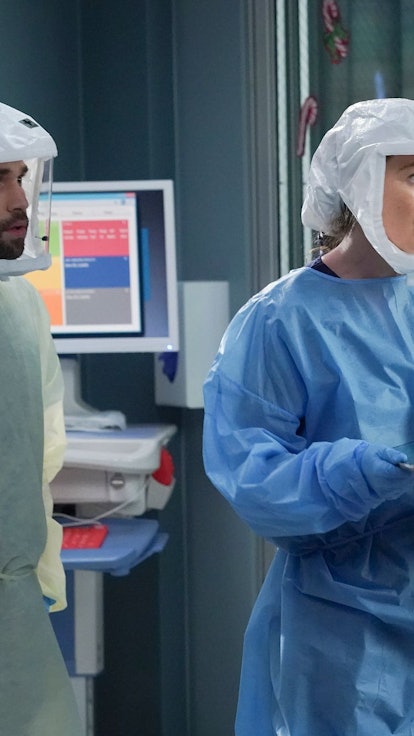It's hard for Grey's Anatomy, which has been on for 16 years, to surprise its fans anymore but this season, there were some shocking moments and changeups, both big (hello, Alex Karev moving to.... Kansas!?) and small, as cinematographer Alicia Robbins explained to me when I noticed that this season just... looked different.
Robbins has been working as a director of photography on Grey's since 2019 (she worked on For The People and a number of shows and movies before that) and she's responsible for the look and feel of some of the most iconic scenes in recent Grey's history. Take, for example, the Season 16 episode "Silent All Of These Years," where Jo walks a trauma survivor down the hallway with all of the female nurses and doctors lining the walls.
But the COVID storyline this season meant that Robbins and her team had a chance to change the overall look of the series, for good. So if you found yourself noticing that everything just looked and felt different in Season 17, it wasn't just you.
These are some of the biggest ways Robbins and her crew overhauled our tried and true show.
Digital Flowers
This season, Robbins spearheaded those dreamy beach episodes, including the one with Mark Sloan and Lexie Grey, which was filmed without actress Chyler Leigh, a true feat of visual effects (VFX) technology, she tells me.
That wasn't the only trick the VFX team pulled off either, Robbins says. "There were a lot of digital replacements just for the environment, like all those flowers. They weren't there, only the ones that were directly around them were. So the effects replace a lot of the backgrounds; the brown backgrounds turn into flowers and greenery," she tells me.
Lighting The Dream Beach
We don't often get location shots on Grey's Anatomy — most everything is filmed on a studio lot in Los Angeles, which is one reason all of those beach scenes were so compelling. Filmed in Palos Verdes, California, Robbins says that she and the Grey's team thought long and hard about how the beach was going to feel.
"Even though this was supposed to be a dream state, it had to feel like it was still based in reality. So maybe this is a beach that she has visited before and this is just sort of a happy place for her. So we weren't necessarily looking to make it this ethereal place that didn't feel real, we wanted it to feel real," she says.
Robbins also wanted to make sure it was as "beautiful as possible," which meant playing around with the lighting most of the time and scheduling things based on where the tide and sun was at any time of day, something they normally don't have to contend with in the studio.
Robbins explains, "You can see it especially with our Patrick Dempsey scenes. There are a lot of times that we filmed half of the scene in the morning looking one direction and then we would flip and do the rest, looking the other direction when the sun had actually moved. So you'll see that it's backlit in two different places. But no one thinks about the fact that the sun was over there before and right now, the sun's over there. No one notices that. Or maybe they do. But no one cares. Like, as long as the actors look great, then it doesn't matter where the sun really is at that point."
It's true, who's looking at the position of the sun when McDreamy is taunting Meredith about coming closer to him on the dunes?
A Modernized Hospital
One thing you might not have noticed is that Robbins and her crew updated the actual set. Because of COVID, they had to build new sets to tell the pandemic story, which gave them an opportunity to start fresh when it came to the general feel and tone of the show. Robbins pulled inspiration from actual hospitals, which nowadays often use LED lights to mimic circadian rhythms for both patients and staff. So darker lights where people are recuperating and then brighter lights over the nursing stations, since people have to be up and at 'em around the clock.
Robbins says, "Grey's Anatomy traditionally has been a white light show where it's just very neutral. And the only time that you would see a little bit of color shift was at night. That was it. But for this season, we really shook that up."
"There's this one scene that you really kind of see it. It's when DeLuca and Bailey [in Episode 6] are having this heart to heart in the middle of the nurses station in the ICU COVID ward," Robbins says. "So over the nurses station is all this blue lighting, because the idea is that blue lighting helps you stay awake and alert, whereas all in the background where the patients are sleeping, it's very dark," she adds.
About Those Masks...
Robbins used light to convey how stressful working throughout a pandemic really was. "Every time someone might be stepping outside to take a mask break, we always try to incorporate a really beautiful, warm, streaky sun. So it felt like a breath of fresh air from the colder hallways of the colder hospital areas that these doctors are having to work in all the time because they're having to stay awake," Robbins adds.
Although we mostly tune into Grey's for the major drama, it's this kind of attention to detail that makes it truly great.
Images: ABC


